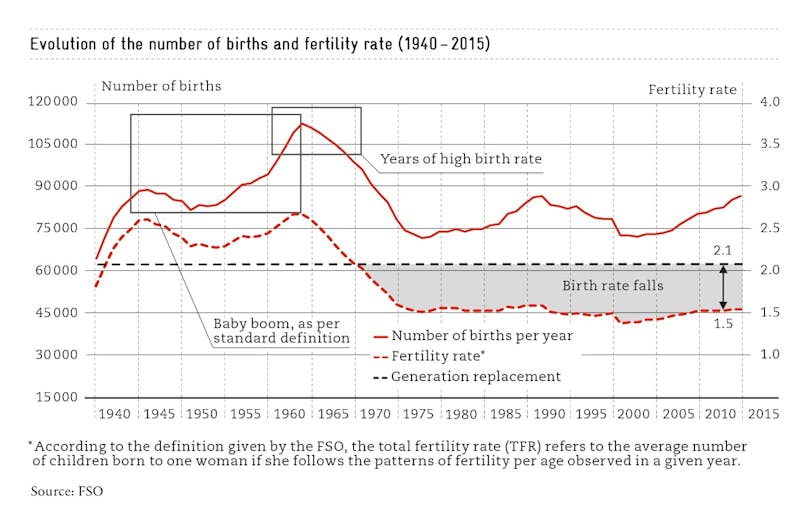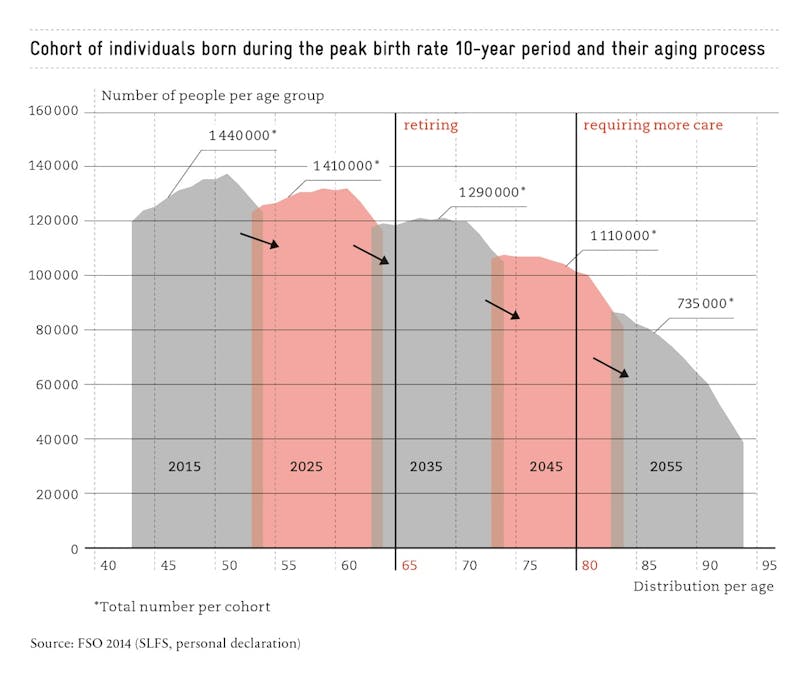What just happened to demography? For years we were warned about the consequences of demographic change: aging population, saturation of pension schemes, shortage of skilled workforce, decline in tax revenues, and decrease in economic growth forces. Yet, the transformation went by unnoticed in our daily lives, and as a consequence, the aging of the population continued to be an abstract thought. So far, we have barely witnessed a “latency phase” in demographic change, and it is gradually drawing to an end. The consequences of an aging society will now be felt more as we reach a threshold in the large retirement wave of baby boomers.
The demographic evolution of society is a gradual process. It is only now that we can feel the impact of certain events that took place one or even two generations ago, as is the case with the “baby boom” following the economic recovery after the Second World War. In the 1940s, Switzerland observed two drastic increases in birth rates, reaching a peak in 1964 (see graph below). Then, along came the contraceptive pill and, with it, a decline in the curve of birth rates, a result known as the “pill effect”; birth rates continued to decline steadily until they stabilized at a weak level in the 1970s. Switzerland’s demographic model, albeit with some differences, is quite similar to most countries of the Western world. The desire to have more children started in the United States just after the end of the war, while other countries, such as Germany, were more concerned with rebuilding their devastated cities. Curiously, the long-term decline in birth rates was less dramatic in France after the “pill effect.”

Baby boomers and an aging society
During various decades, baby boomers exercised a crucial influence over the economic and societal structure—on the one hand, because of the number they represent and, on the other, because they constituted a relatively homogenous generation. During the various phases of their life cycle, the baby boomers shaped society in a number of ways. Now as they are aging, society as a whole is aging with them.
Demographic change is undeniable. Before exposing the consequences and problems it entails, it is important to establish a distinction between two definitions when we talk about “baby boomers.” As per the common definition, baby boomers are the individuals born between 1945 (after the Second World War) and 1964 (when the peak in birth rates was reached, and the “pill effect” began). Nowadays, more age groups will be retiring each year—the number of new pensioners will continue to increase annually until 2030. Already in 2016, there were more domestic workers exiting the labor market than entering it for the first time.
A more prudent but unusual definition of the baby boomer generation is the cohorts born during the 10-year natality peak before and after the “pill effect” (from 1961 to 1971). The aging process of the population for these cohorts is represented in chart below. From a social perspective, a delicate phase will have to be addressed when these people reach the age of retirement or require special care (approximately at age 80). These threshold years are illustrated in the chart.

Consequences across many categories
The pivotal point in demographic change starts when baby boomers reach retirement age. There are key consequences—particularly on the economic wellbeing of our country. What do these concretely entail ?
- Retirement system : With the retirement of baby boomers, the cohort of pensioners increases while the number of contributors decreases. In other social institutions as well, the disequilibrium between expected benefits and their financing brings forth further pressure.
- Labor market : Young graduates entering the labor market today, stem from a low-birth-rate generation. Consequently, there is a significant diminution in the number of domestic employees and qualified workforce. This can be remedied thanks to immigration. Otherwise, the result is an increase in costs and a longer search period for companies.
- Growth : The decrease of working individuals reduces the economic growth per capita, especially since the innovation force diminishes as the average age increases. Standards of living stagnate. In a low-growth environment, the political struggles for distribution tend to intensify.
- Public Finances : Fewer workers and a weaker economic growth globally translate to a reduction in tax revenues. In the meantime, government spending increases due to the demographic change, in particular in areas such as social services, health, and care.
- Politics : With the exit of baby boomers from the labor market, the political majority moves from the younger to the elder generation, from contributors and tax payers to the net beneficiaries of public services. This could lead to an increase of public spending share.
Undertake the necessary reforms
Overall, the room for policy leeway will diminish, and disputes over allocations will increase. Reforms must be tackled now in order to mitigate the negative economic and social consequences of the imminent aging population.
- Social Insurance : Increase of the retirement age, decrease of the second pillar conversion rate, consolidation of the AVS funds, measures against the continuous increase of social expenditure.
- Labor market : Skilled labor immigration, increase of women’s participation rate by improving the compromise between work and family with the introduction of individual taxation, more flexible work patterns for senior workers, additional measures for professional training.
- Growth : Framework conditions contributing to increased productivity, such as reduced regulations and economic, educational, and scientific policies that reinforce the potential for innovation.
- Public Finances : Budgetary discipline (especially for ever-increasing consumer spending), decrease of subsidies, and coherent application of the debt brake.
Migration delays the aging of the population
Switzerland, a country prone to migration, has maintained a high level of immigration for many years, and immigrants are, on average, younger than the local population. Consequently, the aging of the population as a whole is diluted or even delayed over time. Hence, migration rejuvenates both society and the economy—even more so with the Free Movement of People, where immigration is essentially a labor movement. The consequences of the aging of baby boomers are, therefore, not as pronounced in Switzerland as they are in other countries with lower immigration.
Internal migration has a similar effect in Switzerland on a regional level: cantons and municipalities that experience a higher emigration of their inhabitants are aging much faster. Thus, the demographic indicators of some remote valleys are comparable to those of Eastern Germany or the French provinces. Conversely, cities and agglomerations benefit from these migratory flows and see immigration as a fountain of youth.
The gap between regions that become “younger” due to immigration and those that become “older” because of emigration is reflected in the large average age difference in the cantons. It ranges from age 39 in Fribourg to age 44 in Ticino. As a result, some parts of the country are already experiencing a demographic evolution that will affect the rest of Switzerland in the coming years.
Who will replace the baby boomer Generation ?
Currently, the abundant number of baby boomers are at the height of their creative aptitude; many of them occupy key functions in private companies and public administration, as well as in the areas of culture and science. They have a strong influence on institutions and social discourse—but only for a few more years. It will be interesting to observe the generations that will follow the baby boomers and how their characteristics will shape the Switzerland of tomorrow. Who are the heirs of the baby boomer generation ?
- Generation X : Those born after the baby boomers until approximately 1980. Among their most commonly attributed characteristics, we can state a high level of education, strong consumerism, and individualism.
- Generation Y : Those born between 1980 and 1999. They also have a high level of education and are technological enthusiasts; they gladly question conventions and attach a great importance to self-fulfilment.
- They are closely followed by the millennials, a generation strongly influenced by the digitalized era and social networks.
With the gradual withdrawal of baby boomers from the labor market, we see a fundamental change in the structure of future generations. The heirs of baby boomers are shaped by experiences, values, characteristics, and behaviors different from those of the baby boomers. But what awaits them in the world that baby boomers built and will entrust to them now ?





